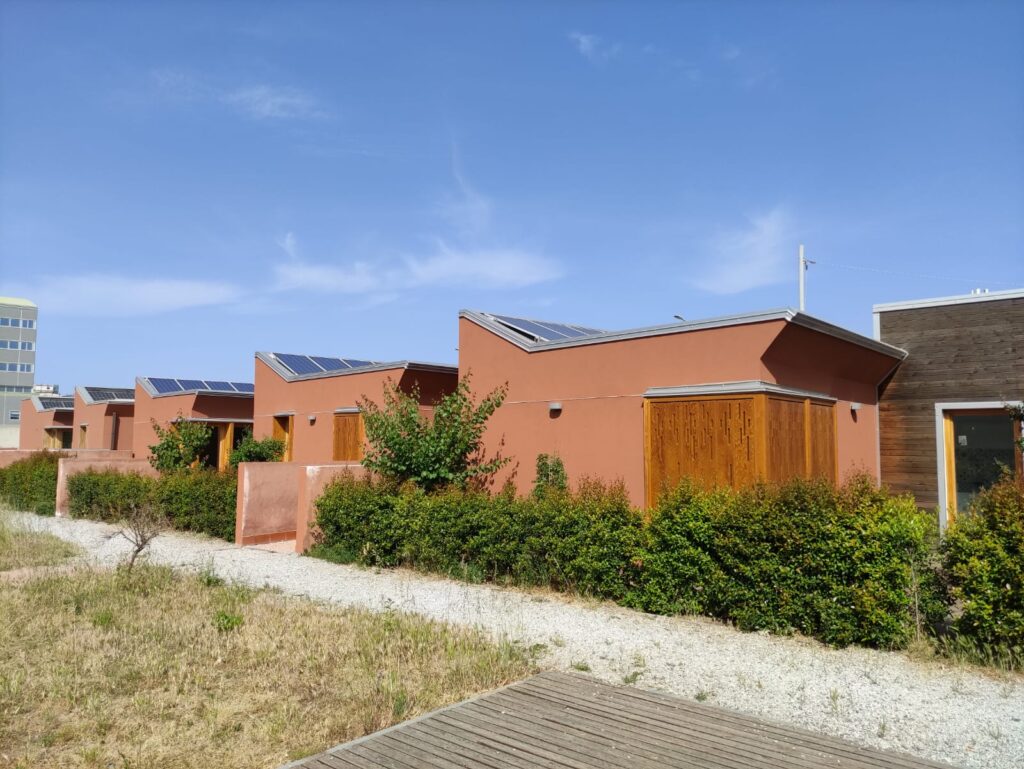The Fondo Saccà urban redevelopment project was created with the purpose of initiating an urban regeneration experience by considering new housing models and new possibilities for public space fruition, with the aim of transforming urban space into an active laboratory.
It takes place in a city, which is Messina, destroyed and rebuilt on the same place with new urban characters and new directions of development emphasized by their respective orthogonals, the torrents with a texture shaped by the repetition of homogeneous forms with scattered differences, a simple, repetitive but surprising settlement form for all the possible variations it presents. The study of building orientation, climate and environmental data collected further influenced the design and engineering choices.



In a space in which directions drawn toward the sea prevail, buildings take different heights depending on their distance from the coast and contribute to orienting the longitudinal section toward the Strait by accommodating the slight slope of the ground. The volumes are crossed by two pedestrian paths along which housing entrances are placed. The housing units organized in couples around the central patio are almost blind, preferring views toward the park and foreshortening toward the urban context also to accommodate the technological characteristics of the building system identified for the construction of the perimeter walls. The latter are made of prefabricated factory-fabricated elements consisting of a glulam frame which performs the static function in which are compacted 7 bales of straw from the waste of the local agricultural industry without any treatment, 35 cm. deep, 45 cm. high and 110 cm. long and sealed with lime-based undercoat.

The lime coating layer makes the straw virtually aseptic, thus preventing infestation by parasites and/or rodents. The decomposition process is blocked by the reduced percentage of humidity in the panel, which fluctuates in synergy with the surrounding environment.

The resulting prefabricated individual panels will make up the modules with overall dimensions of 120 x 36 x 232 cm by which the housing units will be sized. Prefabrication will not only promote production efficiency, consequently decreasing overall costs, but will also help reduce the amount of waste generated. This type of system allows buildings with good thermal performance and rapid construction. The entire process, from raw material supply to manufacturing, has been carefully refined to minimize waste. All raw materials are reusable, the panels can be disassembled, and all components reused, recycled, used as biomass, or composted safely. The high thermal inertia building envelope, solar energy supply defined by the orientation of some openings, a natural ventilation system, and the choice and arrangement of greenery contribute to optimizing consumption and minimizing environmental impact.

In matters of energy optimization, cumulated with high thermal efficiency, the horizontal prototype residential building is equipped with a plant, made up of monocrystalline photovoltaic modules and three-phase inverter for a power output of 16 kWp and an estimated energy output of 22,400 kWh associated with a 40 kWh storage system.
In collaboration with the CNR-ITAE, S&E has experimented in the Fondo Saccà microgrid a new model of electricity sharing using an innovative monitoring and control system that can contribute to the mitigation of climate change by promoting and incentivizing the participation of the most deprived groups in the neighborhood. In addition, an innovative pricing algorithm for microgrid members has been developed and is being tested.
The goal of S&E and CNR-ITAE is to develop a renewable energy community which allows for the sharing of incentives and benefits gained by community members based on three basic principles:
- the reduction of economic inequalities;
- the encouragement of members who use energy virtuously;
- the reduction of inequalities arising from social and health problems.
To effectively monitor system characteristics, individual building units are equipped with thermal and energy monitoring sensors such as: thermal comfort sensors in the building (atmospheric particulate matter, temperature, humidity), smart meters for energy consumption for each customer and each PV system, outdoor weather station with sensors for rain gauge, irradiance, anemometer, temperature, humidity.
The Fondo Saccà facility is involved as a demonstrator site for the European research and innovation project Horizon2020 – H2020-LC-BAT-2019-2020 – HYBRIS (“Hybrid Battery energy stoRage system for advanced grid and beHInd-de-meter Segments”). The Hybrid Energy Storage System will be connected to the micro-grid and due to the ability to operate in island-mode can be tested for service delivery in island grid. It will be possible to test the advantage of the hybrid storage system for:
- Renewables balancing;
- Backup power;
- Frequency regulation service can be investigated driving the active power of the HESS through the following of a signal that simulate the request from the system operator (tertiary frequency regulation);
- Implementing an automated interphase which simulate the drop and dead band, allow an automated reaction in terms of active power to provide primary/secondary frequency control investigation.
Authors: Francesco Bertino – Santi Smedile for Solidarity and Energy S.p.A. Impresa Sociale
